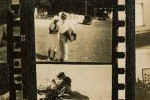The modest violet
AJH "John" Goodwin was a South African-born, Cambridge-trained archaeologist, who returned to the country in 1923 to take up a post at the University of Cape Town. A contemporary of Louis Leakey (1903-1972), Goodwin was one of the first professional archaeologists to work in sub-Saharan Africa. He was largely responsible for the establishment and institutionalisation of South African archaeology in the period from the mid-1920s to the late-1940s. Together with Clarence "Peter" van Riet Lowe (1894-1956), he set in place a basic nomenclature and typology for the African Stone Ages that is still in standard usage today (Goodwin & van Riet Lowe 1929). In the mid-1940s Goodwin was instrumental in the founding of the Archaeological Society of South Africa, and was the founding editor of the South African Archaeological Bulletin, the longest established archaeological journal in Africa with a continuous record of publication (Deacon 1990). At the same time, he was a complex and disappointed figure. After a brilliant start, his career got bogged down in institutional conflict, personal tragedy, and an inability to get along with key figures. He felt that he was denied the recognition that he deserved. Within the academy, he was in the orbit of local stars – Monica Wilson and Isaac Schapera in anthropology, Lewis Leakey in archaeology – without joining their ranks.
Goodwin was a secret writer of fiction, most of which was unpublished. The boxes of the Goodwin Collection contain the typescripts of a number of short plays and fragments, many of them written under pseudonyms (Shepherd 2012). These include The Merchant of Cape Town by AJHG, Brilliance by Sour Grapes, Underexposed by MQ Pyro-Soda, Soft Goods by A Flat, and the promisingly louche The Sultan; or, A Peep into the Seraglio. Most of the plays echo the style of Mandrake Passes, another one of the pieces in the collection, whose opening scene is depicted as follows: "A panelled smoking room. There is a door back centre, which opens forward on to the stage, to conceal partially a small butler's table. Down stage centre are two club-easies, facing a small occasional table. When the curtain rises, Patricia and Mandrake are seating themselves in the club-easies…" There is also Noises Off, an attempt at a kind of Brechtian modernism, with a cast consisting of "A man with a garden roller; A man with a whistle; A man with a compressed-air cylinder; A man with a tumbler and mirror; A man with a bowler hat". The Ray is memorable for featuring "Colonel Soblightly: in charge of the South African War Office" and "Egbert Jefferson Gink: Inventor". In addition to the plays there is an operetta, a sheet of "Limerix", two other short stories ("The Einstein Wells Machine", written at Cambridge, and "For Two Pins", written later), a novel, and a long poem on archaeological method. The first stanza of the long poem runs as follows: "For the maximum yield when you work in the field / Two aims should be well kept in mind / The first is, Retain ev'ry object you gain / And preserve ev'ry interesting find".
"For the maximum yield when you work in the field
Two aims should be well kept in mind
The first is, Retain ev'ry object you gain
And preserve ev'ry interesting find"
Sprawling, abundant, and ill-disciplined, the Goodwin Collection runs to over a hundred boxes in the Manuscripts and Archives division of the University of Cape Town Library. Goodwin died in office, and rather than being a highly selected donation his collection has the look and feel of a general sweep of the contents of his desk drawers and filing cabinets. One folder holds the contents of his in-tray, unanswered letters from the weeks leading up to his death. The boxes contain manuscripts and typescripts, lecture notes, field notebooks with the dust of deposit still on them, and a voluminous correspondence. They also contain thousands of photographic prints, plates and negatives. The form of this photographic archive follows the developing technology of the period, and ranges from glass plates ("Ilford Ordinary Plates"), to individual negatives in celluloid envelopes, to rolls of film, and finally to colour slides. The film wallets carry slogans like "Perutz Film: For pictures that live", and "Snap it quickly with a Kodak".
"A man with a garden roller; A man with a whistle; A man with a compressed-air cylinder; A man with a tumbler and mirror; A man with a bowler hat"

Goodwin was a keen and enquiring photographer. In one experiment he took three shots of the same rock-art panel with different kinds of film, to test the results. In his textbook on archaeology written for local conditions, Method in Prehistory (1945), he writes about the proper use of photography as a fieldwork technique. In most of the photographs in his collection, Goodwin is behind the lens. A set of five passport-style photographs is unusual in that Goodwin himself is the subject. In another two photographs in the same folder he appears with his friend, the University of Cape Town-based psychologist James "Jimmy" Taylor (1897-1973). Taylor may be the photographer in the case of the first five images. Part of the appeal of these images is their playful, informal nature, as Goodwin mugs for the camera. On the back of one of the photographs Goodwin has pencilled the word "soulful". On another, in which he appears with averted gaze, he has written "the modest violet".

